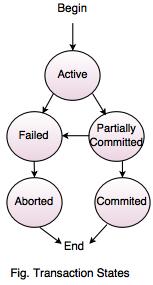Database Transaction Control
Introduction to Database Transaction
- Database Transaction is an atomic unit that contains one or more SQL statements.
- It is a series of operations that performs as a single unit of work against a database.
- It is a logical unit of work.
- It has a beginning and an end to specify its boundary.
Let's take an simple example of bank transaction, Suppose a Bank clerk transfers Rs. 1000 from X's account to Y's account.
X's Account
open-account (X)
prev-balance = X.balance
curr-balance = prev-balance – 1000
X.balance = curr-balance
close-account (X)
Decreasing Rs. 1000 from X's account, saving new balance that is current balance and after completion of transaction the last step is closing the account.
Y's Account
open-account (Y)
prev - balance = Y.balance
curr - balance = prev-balance + 1000
Y.balance = curr-balance
close-account (Y)
Adding Rs. 1000 in the Y's account and saving new balance that is current balance and after completion of transaction the last step is closing the account.
- The above example defines a very simple and small transaction that tells how the transaction management actual works.
Transaction Properties
Following are the Transaction Properties, referred to by an acronym ACID properties:
1.
Atomicity
2.
Consistency
3.
Isolation
4.
Durability
- ACID properties are the most important concepts of database theory.
- A transaction is a small unit of program which contains several low level tasks.
- These properties guarantee that the database transactions are processed reliably.
1. Atomicity- Atomicity defines that all operations of the transactions are either executed or none.
- Atomicity is also known as 'All or Nothing', it means that either perform the operations or not perform at all.
- It is maintained in the presence of deadlocks, CPU failures, disk failures, database and application software failures.
- It can be turned off at system level and session level.
2. Consistency- Consistency defines that after the transaction is finished, the database must remain in a consistent state.
- It preserves consistency of the database.
- If execution of transaction is successful, then the database remains in a consistent state. If the transaction fails, then the transaction will be rolled back and the database will be restored to a state consistent.
3. Isolation- Isolation defines that the transactions are securely and independently processed at the same time without interference.
- Isolation property does not ensure the order of transactions.
- The operations cannot access or see the data in an intermediate state during a transaction.
- Isolation is needed when there are concurrent transactions occurring at the same time.
4. Durability- Durability states that after completion of transaction successfully, the changes are required for the database.
- Durability holds its latest updates even if the system fails or restarts.
- It has the ability to recover committed transaction updates even if the storage media fails.
Transaction States
- A transaction is a small unit of program which contains several low level tasks.
- It is an event which occurs on the database.
It has the following states,
1. Active
2. Partially Committed
3. Failed
4. Aborted
5. Committed
 1. Active :
1. Active : Active is the initial state of every transaction. The transaction stays in Active state during execution.
2. Partially Committed : Partially committed state defines that the transaction has executed the final statement.
3. Failed : Failed state defines that the execution of the transaction can no longer proceed further.
4. Aborted : Aborted state defines that the transaction has rolled back and the database is being restored to the consistent state.
5. Committed : If the transaction has completed its execution successfully, then it is said to be committed.
